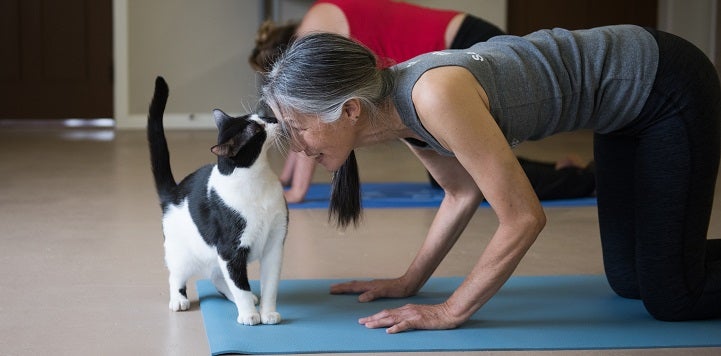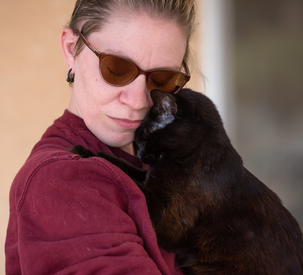
When rescuers need rescuing: managing our mental health
For all the highs that come with helping animals, the work also comes with some pretty low lows. Animals come to us sick or gravely injured, we have highly charged interactions with people and we witness sometimes tragic situations where we can’t help. Daily. Those are heavy loads for anyone to bear, much less the idealistic, passionate kind of people who gravitate to animal welfare.
“The movement attracts people who are particularly empathic and who want to help the voiceless,” says Elizabeth Fagan, a corporate mental health specialist and equine therapist. “Such individuals may even come in with predetermined sensitivities in their own lives about what it's like to not have a voice or to be victimized.”
Elizabeth has worked with many clients, including Best Friends, who have staff coping with what we commonly call burnout or compassion fatigue. In fact, there’s a distinction between the two. Compassion fatigue refers to witnessing trauma happening to others, while burnout is a chronic condition marked in part by hopelessness and a lack of motivation.
While many have healthy coping skills to buoy them through their most challenging days, even the most upbeat individuals can find themselves in a dark valley, emotionally speaking. There’s no replacement for access to professional therapeutic resources, but there are also ways we can build resiliency in the workplace – both for ourselves and others.
“We can’t just ignore our pain,” says Elizabeth. “In fact, we need our pain to show us where we need help so that we can cope with the suffering and the frustration that just comes with the territory.”
The art of radical acceptance
 Compartmentalizing in the face of distressing situations is not necessarily a poor defense mechanism – unless you never plan on addressing those emotional wounds at a later date. I personally have many ugly memories from my 20 years in animal welfare. Right now, they’re walled off in the far corners of my psyche, and I’m in no rush to dust them off to process them. According to Elizabeth, though, I might be setting myself up for a fall.
Compartmentalizing in the face of distressing situations is not necessarily a poor defense mechanism – unless you never plan on addressing those emotional wounds at a later date. I personally have many ugly memories from my 20 years in animal welfare. Right now, they’re walled off in the far corners of my psyche, and I’m in no rush to dust them off to process them. According to Elizabeth, though, I might be setting myself up for a fall.
“People who work in shelters see some horrific things, which contributes to feelings of powerlessness and learned helplessness,” Elizabeth says. “Many of us focus on becoming numb or hardened by pushing our feelings down. That’s like holding a ball underwater. It will pop up again eventually.”
If, like me, you have a lot of baggage stashed somewhere, it’s best to work with a professional to unpack it all. One healthy technique you can learn to employ is built around radical acceptance, described by Arlin Cuncic, author of The Anxiety Workbook, as follows:
“Radical acceptance does not mean that you agree with what is happening or what has happened to you. Rather, it signals a chance for hope because you are accepting things as they are and not fighting against reality. While this can be hard to practice when things are going very badly, letting your emotions run wild will only add to your suffering and the pain you are experiencing.”
“Radical acceptance says, ‘This is how I feel today about a particular incident – I don't have to deny it. I don't have to fight it. I don't have to judge it. It just is what it is,’ Elizabeth says. “That avoids those wide pendulum swings from ‘I must be the one to fix this’ to ‘I have no ability to help and I’m going to give up.’
Everybody deserves a break
Setting limits on what’s your responsibility and what’s not is a bit easier if you have something else in your life besides helping animals. That means taking your days off – really off – and getting involved in exercise, hobbies, volunteer work, etc. It’s also probably good if those other things aren’t as emotionally charged as animal welfare. And that brings up the topic of social media.
 “Social media is an important way to connect, and connection is vital, Elizabeth says. “But exposing yourself to the constant inundation of upsetting information will create cumulative grief and trauma. Hitting the button over and over and over again keeps your nervous system elevated when you need to let it calm down.”
“Social media is an important way to connect, and connection is vital, Elizabeth says. “But exposing yourself to the constant inundation of upsetting information will create cumulative grief and trauma. Hitting the button over and over and over again keeps your nervous system elevated when you need to let it calm down.”
Author Bessel van der Kolk posited in his book “The Body Keeps the Score” that “a constant sense of danger and helplessness promotes the continuous secretion of stress hormones, which wreaks havoc with the immune system and the functioning of the body’s organs.”
In other words, if you don’t choose to take your vacation days or limit the number of dogs you foster in your “off time,” you eventually may not have a choice. Janette Nevils experienced such burnout in her role as cat care manager at Best Friends Los Angeles that she felt the need to take a break.
“We took in 3,000 kittens a year, so I was used to managing high levels of stress and waves of emotions with high expectations of what we could accomplish,” she says. “We also dealt with a lot of death from panleukopenia and other diseases. There was a constant hum of what I know now to be traumatic events, but we kept telling ourselves that we had to keep going because there were always more kittens who needed to be taken care of.”
Janette moved into a less-stressful position as operations coordinator and returned to school and is now writing a thesis on preventing burnout through resiliency to earn her PhD in industrial and organizational psychology. In 2019, she switched to the role of strategist for culture and employee experience.
“The nature of this work is innately difficult, and that's not something you can ever really get away from,” she continues. “But what you can do is ensure that staff experiencing any level of stress are able to identify and work through their emotions and have opportunities to de-stress so that they are able to bounce back from those stressful and traumatic events and continue to show up in a healthy physical, mental, and emotional state.”
It’s not all talk
Lay the groundwork for hard conversations by bringing the topic of mental health out into the open. Posting flyers on bulletin boards that ask, “Are you suffering from burnout? You are not alone” with info about online or in-house resources can send the message that it’s not taboo to bring up the topic.
Making literature available that explains what compassion fatigue or burnout look like is important, too, as some people may not recognize that persistent headaches or a change in eating habits can be linked to being overwhelmed.
 Setting the stage for talking about the hard stuff means everybody – but definitely managers and leaders at all levels – should be prepared to do so.
Setting the stage for talking about the hard stuff means everybody – but definitely managers and leaders at all levels – should be prepared to do so.
“Staff should feel like they can speak to their managers without fear of repercussions, and they deserve to be talking to someone who is actively listening to them,” says Meryl Schwarz, a certified professional coach specializing in ADHD and compassion fatigue. “Remain present in the conversation, listen more than you talk and ask questions to help people express what they're feeling. If they say they’re lonely, find out what that means to them rather than just interpreting it through your personal experience.
“On the listening end, you should validate those feelings – even if you don’t agree with them,” she continues. “Just saying something like, ‘That sounds really awful and it sounds like you’re really sad. What is something you can do for yourself this week?’ is important.”
“Sometimes just acknowledging a situation is enough to release it,” says Elizabeth, who also refers many of her animal welfare clients to the article “What to do about compassion fatigue” on Petfinder.com. Among the suggestions covered in the article, or suggested by Elizabeth, Meryl or Janette, to help process emotional distress:
- Develop a spiritual or meditative practice. Tara Brach has a website with a range of free guided meditations and talks on various topics. Meditation “restores the body to a calm state, helping the body repair itself and preventing new damage from the physical effects of stress,” according to author and educator Elizabeth Scott, PhD.
- Learn some deep breathing techniques. Just breathing in and then breathing out twice as long actually turns on your parasympathetic nervous system, which relaxes your body after periods of stress or danger.
- For shelter leaders, provide staff with a quiet place where they can go to write in a journal, do yoga or light a candle and sit quietly. Develop a culture where people understand and support the need for their colleagues to take themselves out of the moment sometimes so that they can get re-centered and return to work.
- Provide opportunities to have fun at work: play trivia, host team lunches or promote a 15-minute speed walking break during the afternoon. The activities can be brief – even a minute long – and can be built to support remote as well as in-person staff. Janette recalls a meme competition she created for the staff in Los Angeles to play.
- “I would give a prompt like, ‘you just realized that the kitten you're holding has ringworm,’ and people would have to find the best meme that fit that prompt, it got pretty hilarious” she says. “Even if you are doing something silly, the goal is to give people an outlet to de-stress and remove themselves from whatever is taking up space in their mind. It’s an opportunity to reset and connect with colleagues.”
- Set realistic expectations by balancing aggressive goals with achievable milestones along the way. No matter how cognizant we are of our emotional needs, people in this want to give excellence to the animals in our care. Falling short of that goal in and of itself can create emotional distress.
“Success is not a straight line,” says Meryl. “If you do the best that you can do every day, that’s the most you can ask of yourself. “While the struggles are always going to be there, if you have systems in place to take care of yourself, they can lift you out of those dark valleys.”
Then we can all get back to the work of enjoying those high highs of caring for animals.
Check out the second part in this series, From surviving to thriving: an interview with José Ocaño and The Best Friends Podcast episode, Managing our mental health.

Liz Finch
Senior Writer
Best Friends Network
If you enjoyed this program spotlight, you can find our complete catalog of spotlights here.